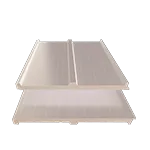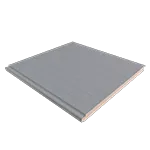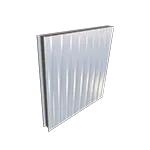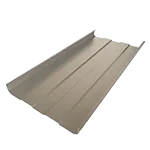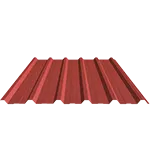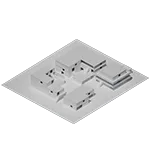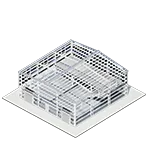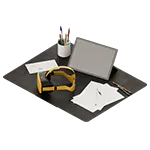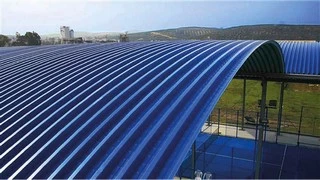For a long time, architecture has been evolving according to technical construction advances. The development of new materials has allowed increasingly risky designs to transform our cities’ skylines or provide spaces that enrich the user experience.
The use of curved or vaulted ceilings is not something new, however, during the 60s and 70s in the rise of architectural rationalism, this type of construction solution was displaced by flat roofs with cantilevers or various slopes, since the utility prevailed over any other need.
Starting in the 90s, given the need for large logistics, storage, or manufacturing spaces without intermediate structures that condition the workspace, the idea of curved or vaulted ceilings that liberate large areas without the use of intermediate columns returns.
Structureless Roofing System
A curved roof is a roofing system designed with a gentle curvature that follows a curved or curved-like profile. It is an aesthetically pleasing and functional feature of many buildings, including commercial buildings and pre-engineered structures.
Self-supporting curved ceilings allow large spans to be freed without intermediate columns, and in some cases minimize the secondary structure, since the curved profile itself has a double function as a self-supporting element and cover. The most common materials used are steel and aluminum. The latter is more used due to allowing lower costs and less weight for the structure.
There are two types of curved roofs – those with structure, which are built with supporting trusses, and structureless roofs which are self-supporting and do not require additional framing.
Benefits of Self-Supporting Curved Roof System
A self-supporting curved roof system is an increasingly popular choice for commercial buildings due to its many advantages over other types of roofing systems. This cutting-edge technology offers multiple benefits, including enhanced aesthetics, better resistance to wind and precipitation, natural light diffusion, and increased energy efficiency.
One of the most significant advantages of a self-supporting curved roof is the unique shape itself. The curvature of the roof offers enhanced aesthetics, as it creates a striking and modern appearance that sets the building apart from others. Furthermore, the curved shape also provides better resistance to wind and precipitation, as the roof efficiently disperses the forces of nature across the entire structure.
Another significant advantage of a self-supporting curved roof is the natural light diffusion it offers. The curved surface of the roof minimizes the need for artificial lighting during the day, as sunlight easily penetrates into the building, reducing the need for energy-consuming lighting systems. This feature positively impacts the building’s energy efficiency, as well as the occupants’ health and well-being.
Self-supporting curved roofs are an excellent option for reducing the need for support structures. This means that the building frame can be constructed with fewer materials, reducing the cost of construction and simplifying the process of designing the building. Moreover, the option of customization facilities allows architects to create tailored curved roofing systems that meet their clients’ unique requirements.
To achieve optimal user satisfaction, it is essential to adopt quality standards when choosing materials for the curved roof. Cheap quality clamps and unreliable roofing systems can lead to some drawbacks, such as the need for frequent maintenance and increased costs over the long run. Therefore, it is crucial to choose quality products, such as stainless steel or aluminum sheet, as they are durable, corrosion-resistant, and provide reliable performance.
Types of Self-Supporting Curved Roofs
When it comes to roofing systems, self-supporting curved roofs provide a unique solution with modern aesthetics and practical benefits. There are various types of self-supporting curved roofs available, each with its own advantages and features. Some popular choices include seam roofing and the self-supporting curved roof system. These roofing systems offer great functionality, customization options, and are ideal for commercial buildings and pre-engineered building services. Let’s take a closer look at these types of self-supporting curved roofs.
Structureless Roofs
Self-supporting curved roofs, also known as structureless roofs, are a modern roofing solution that offers several benefits. These roofs are designed to require no additional support structures like beams or columns to keep the shape intact. The resulting structure is lightweight, durable, and visually appealing.
The concept of structureless roofs was developed to reduce the material and installation costs associated with traditional roofing systems. As such, it offers numerous advantages for companies with commercial buildings and pre-engineered building services. The reduced installation time is a major advantage, as it allows businesses to complete projects faster and with less disruption to their daily routines. Reduced material cost is another significant consideration, as these roofs require fewer materials than traditional structures to create a similar impact.
Self-supporting curved roofs are a popular choice for several types of buildings, including commercial structures and industrial facilities. For instance, warehouses and manufacturing plants require a vast amount of open space to accommodate production processes. Self-supporting curved roofs are perfect for such buildings as they provide an unobstructed view of the work floor. Additionally, the structureless design allows for easier installation of heavy equipment and machinery, enabling businesses to maximize their internal space efficiently.
Another industry that has taken advantage of the benefits of self-supporting curved roofs is the sports arena industry. Stadiums and auditoriums often require a large expanse of open space that can accommodate a crowd. Self-supporting curved roofs allow for uninterrupted views of the playing field, reducing the need for support columns and other structural elements that can detract from the experience.
Seam Roofs
Seam roofs are a type of self-supporting curved roof that incorporates raised seams to create a watertight seal and provide optimal weather protection. These unique roof structures are becoming increasingly popular due to their efficiency, durability, and low maintenance requirements.
Seam roofing systems consist of panels that are joined together using raised seams. The seams are typically made from high-quality steel or stainless steel, which ensures optimal strength and resistance against harsh weather conditions. The raised seams also allow for thermal expansion and contraction, which is important in regions where the temperature can fluctuate significantly.
One of the key benefits of a seam roofing system is its self-supporting nature. This means that the roof does not require any additional support structures, such as trusses or purlins, to maintain its integrity. This feature is especially advantageous for large commercial and industrial structures as it enables them to maximize their internal space and minimize installation time and cost.
Another benefit of seam roofs is their ease of maintenance. The seamless design reduces the number of potential leak points, which minimizes the risk of water damage. Additionally, the panels are easily replaceable, which means that any damaged panels can be quickly and easily swapped out, ensuring a long-lasting and durable roofing solution.
Materials Used in Self-Supporting Curved Roof Systems
Self-supporting curved roof systems are becoming a popular choice for commercial and industrial buildings. These roofing systems are designed to maximize internal space and minimize installation time and cost. One of the key factors that contribute to the success of these systems is the quality of materials used. In the following sections, we will discuss the different types of materials used in self-supporting curved roof systems, their advantages, and how they contribute to the overall efficacy of the roofing solution.
Insulated metal panels
Self-supporting curved roof systems provide numerous benefits for commercial buildings, and one of the key components of these systems is the use of insulated metal panels (IMPs). These panels serve as a roofing solution that offers superior thermal insulation and air tightness, while also being a highly durable roofing material.
IMPs are prefabricated panels made of two metal facings, typically made of steel or aluminum, that are separated by a rigid insulating core. For this, an auxiliary substructure is used, which is usually made of omega profiles, with the shape of a sandwich panel. Both systems allow the insertion of skylights in translucent materials, which facilitate the entry of natural light into the covered spaces. This makes curved roof systems that incorporate IMPs a popular choice for buildings with large, open spaces, such as warehouses, commercial facilities, and sports complexes.
One of the key benefits of using IMPs in self-supporting curved roof systems is their excellent thermal insulation properties. The insulating core of IMPs can provide a high level of resistance to heat flow, which helps maintain a comfortable interior temperature while reducing energy costs. Additionally, because the panels are installed as a continuous system, there are no thermal bridges that would result in heat loss through the roof.
IMPs also offer superior air tightness, which is critical for buildings that have strict air quality standards or that require controlled environments, such as laboratories or data centers. Their construction allows for a tight seal between the panels, which prevents air infiltration and helps maintain interior air quality.
The use of IMPs in self-supporting curved roof systems also provides additional durability and strength. These panels are designed to withstand extreme weather conditions, such as high winds and heavy snow loads. They also resist corrosion and are impervious to water, making them a reliable choice for buildings in high-humidity environments.
Aluminum Sheets
Aluminum sheets are commonly used as the outer facing in self-supporting curved roof systems. This is due to the material’s high strength-to-weight ratio, which makes it an ideal choice for structures that need to withstand heavy loads without compromising on weight.
One of the key benefits of using aluminum sheets in self-supporting curved roof systems is their durability. These sheets are resistant to rust and corrosion, which means they can withstand exposure to the elements without deteriorating over time. They are also relatively low maintenance, which further adds to their appeal.
Aluminum sheets are also lightweight, which makes them easy to transport and install without the need for heavy machinery or additional structural support. This means that self-supporting curved roof systems that use aluminum sheets can be installed quickly and efficiently, reducing installation time and labour costs.
In addition to their physical properties, aluminum sheets can also be customized to meet specific design requirements. This allows architects and builders to create unique and eye-catching building designs that stand out from the crowd.
Overall, the use of aluminum sheets in self-supporting curved roof systems offers a range of benefits, including durability, lightweight, and customization options. For these reasons, it continues to be a popular choice in the construction industry.
Steel Sheets
Steel sheets are another popular option for use in self-supporting curved roof systems. They offer a host of benefits that make them a desirable choice for builders and architects alike.
Firstly, steel sheets are exceptionally strong and durable, which makes them highly resistant to weathering and corrosion especially when an adequate paint coating has been applied. This means that a self-supporting curved roof made from steel sheets can withstand exposure to the elements without deteriorating over time.
In addition to their durability, steel sheets are also relatively low maintenance, which further adds to their appeal. They require minimal upkeep and upkeep costs over the years.
Polycarbonate Sheets
Polycarbonate sheets are a popular material choice for self-supporting curved roof systems because of their many benefits. Firstly, they have a high strength-to-weight ratio, which means that they are incredibly lightweight yet incredibly durable and can support the weight of heavy objects like snow or debris.
In addition to their durability, polycarbonate sheets are also highly resistant to weathering and UV radiation, making them ideal for use in areas that receive high amounts of sun exposure. This means that they will not yellow or become brittle over time, which helps to maintain the aesthetic appearance of the building.
Another advantage of using polycarbonate sheets in self-supporting curved roof systems is their energy efficiency. Polycarbonate sheets have a high level of light transmission, meaning that they can allow a significant amount of natural light into the building. This can reduce the need for artificial lighting, which can lead to lower energy consumption and lower energy bills for the building owner.
Fiberglass Sheets
Fiberglass sheets are a popular material choice for self-supporting curved roof systems and they offer many benefits. Firstly, they are highly durable and resistant to weathering, making them ideal for use in areas that receive high amounts of sun exposure or heavy rainfall.
In addition to their durability, fiberglass sheets are also highly customizable. They are available in a range of colors and profiles, allowing architects and builders to create unique and aesthetically pleasing designs. The sheets can also be easily molded to meet specific design requirements, making them a versatile choice for a variety of building projects.
Fiberglass sheets are also energy-efficient. They have a high level of light transmission, which means that they can allow a significant amount of natural light into the building. This reduces the need for artificial lighting, leading to lower energy consumption and lower energy bills for the building owner.
Moreover, fiberglass sheets are lightweight and easy to install, which can help reduce installation times and costs.
In conclusion
Self-supporting curved roofs have revolutionized architecture and construction, offering numerous benefits for commercial and industrial buildings. These roofs provide open, unobstructed spaces without the need for support columns, maximizing usability and creating a modern aesthetic. They offer enhanced resistance to wind and precipitation, allow for natural light diffusion, and improve energy efficiency.
Various materials, such as insulated metal panels, aluminum sheets, steel sheets, polycarbonate sheets, and fiberglass sheets, contribute to the strength, durability, and customization options of self-supporting curved roofs.
By prioritizing high-quality materials like stainless steel or aluminum, these roofs ensure long-term performance and minimize maintenance costs.
In summary, self-supporting curved roofs are a game-changer in construction, combining functionality, aesthetics, and energy efficiency. Embracing these innovative roofing systems allows builders to create remarkable structures that enhance the user experience and the building owner’s productivity.
